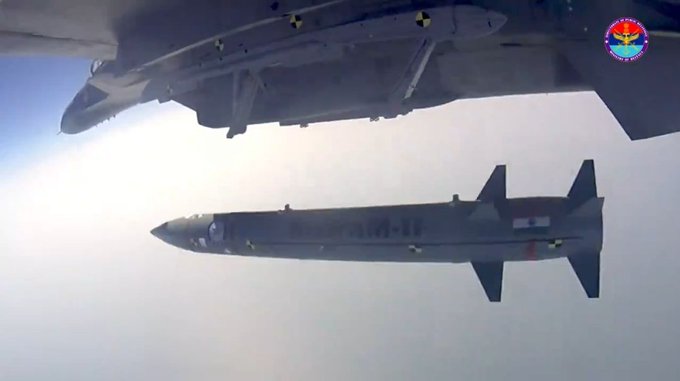SOURCE: RAUNAK KUNDE / NEWS BEAT / IDRW.ORG

Last year marked a significant milestone for India’s defense capabilities as Dr. Samir V Kamat, Chairman of DRDO, confirmed the commencement of flight trials for the Rudram-II Air to Surface (A2S) missile. With a formidable range of 300 kilometers, the Rudram-II represents a cutting-edge addition to the nation’s arsenal. Recently, a video showcasing the developmental testing of the Rudram-II from the Su-30MKI was prominently featured in a promotional video by the Indian Air Force (IAF), underscoring the missile’s pivotal role in enhancing the country’s air superiority.
One of the standout features of the Rudram-II is its versatility, offering two distinct variants tailored to address specific operational requirements. The first variant serves as an anti-radiation missile (ARM), equipped with a PHH-IIR Seeker engineered to neutralize radar installations with unparalleled accuracy. This capability significantly enhances the IAF’s ability to suppress enemy air defenses and establish aerial dominance in contested airspace. Meanwhile, the second variant of the Rudram-II functions as a formidable Ground Attack missile, featuring an IIR Seeker optimized for targeting airstrips, bunkers, and aircraft hangars. This dual functionality further bolsters the IAF’s strategic capabilities and ensures flexibility in mission planning and execution.

The Rudram-II’s combat prowess is further underscored by its impressive warhead capacity, capable of carrying a 200-kilogram payload. This payload capacity allows for the deployment of a wide range of munitions, including high-explosive ordnance and specialized warheads tailored to specific mission objectives. Furthermore, the missile’s extraordinary speed capabilities, reaching Mach 5.5, enable swift and decisive action on the battlefield, ensuring rapid response to emerging threats and adversaries.
Crucially, the Rudram-II is engineered to deliver precision strikes with minimal collateral damage, even at high speeds and altitudes. Designed to impact targets at speeds lower than Mach 1 when launched from altitudes ranging from 3 to 15 kilometers, the missile ensures pinpoint accuracy and minimizes the risk of unintended harm to civilian populations and infrastructure. This precision-guided capability reflects India’s commitment to responsible and ethical use of military force, emphasizing the importance of minimizing civilian casualties in conflict zones.
NOTE : Article cannot be reproduced without written permission of idrw.org in any form even for YouTube Videos to avoid Copy right strikes. Websites doing illegal reproductions will get DMCA and Legal Notices.